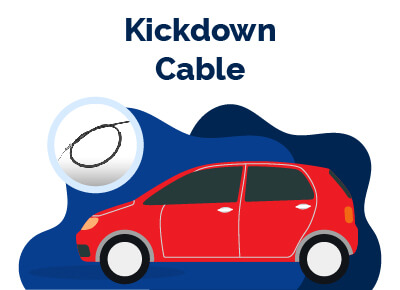Kickdown Cable (Everything You Need To Know)
July 23, 2023


Chris is Head of Content for FindTheBestCarPrice and is based out of Philadelphia, PA. As a seasoned automotive industry analyst and car enthusiast, he ensures the highest level of quality across all our content and curates our picks for the best deals each month.
Chris studied information systems and marketing at Drexel University and writes about a wide range of topics ranging from car buying tips to troubleshooting common mechanical issues.
When he’s not thinking about cars, he likes to stay in with his dog and make an “attempt” to finish a crossword puzzle (he’s not quite at the Saturday/Sunday level…yet). As a former cheesemonger, Chris still has a “sharp” passion for all things cheese, and his fridge is always loaded with it!
Chris also has a passion for things that go fast, and drones are no exception. He spends some of his time writing for Dronesourced.
The automatic transmissions employed in contemporary automobiles are a brilliant feat of engineering, capable of taking a single power input from the engine and amplifying it to enable us to operate at higher velocities and under greater loads.
These capabilities hinge upon the ability of the engine and transmission to communicate reciprocally.
Specifically, the transmission decodes a signal from the engine, such as speed or load, to ascertain which gear is necessary to fulfill the driver's requested criteria.
The transmission's operation can be governed by a cable signal called the kick-down cable. Its function is pivotal for smoother driving, optimal performance, and superior emissions.
However, if the kick-down cable is poorly adjusted or malfunctioning, it can lead to untimely wear and tear and damage.
Table of Contents
- What Is a Kickdown Cable?
- How Do I Know When a Kickdown Cable Is Bad?
- How To Replace a Kickdown Cable
- 1. Lift the Vehicle Up Using Jack Stands
- 2. Disconnect the Kick-Down Cable at the Throttle Body
- 3. Disconnect the Cable From the Mounting Bracket
- 4. Disconnect and Extract the Cable From the Car
- 5. Compare the Replacement Cable With the Old One
- 6. Connect the Cable to the Mounting Bracket
- 7. Reconnect the Cable to the Throttle Body
- 8. Reconnect the Cable to the Transmission Linkage
- 9. Tighten the Cable Housing in the Transmission
- 10. Fine-tune the Cable
- 11. Test Drive the Car
- Best Car Deals by Category
What Is a Kickdown Cable?
The kickdown cable, also known as the throttle valve cable, is a component found in many automatic transmission cars. It is responsible for controlling the downshifts in the transmission when the driver presses down on the accelerator pedal.
When the driver accelerates rapidly, the kickdown cable sends a signal to the transmission to downshift to a lower gear, allowing the engine to rev higher and produce more power. This is useful for passing other vehicles or accelerating quickly from a stop.
The kickdown cable is typically connected to the throttle body and the transmission and is adjusted to ensure that it operates smoothly and accurately. A malfunctioning kickdown cable can cause problems with shifting, acceleration, and overall vehicle performance.
It is important to have the kickdown cable inspected and maintained regularly to ensure the proper functioning of the transmission and engine.
How Do I Know When a Kickdown Cable Is Bad?
Like any constituent, the kick-down cable will exhibit various indications and signals of wear and tear or total failure.
It is crucial to be proactive about replacing the kick-down cable before it ruptures and triggers extensive harm to other transmission components.
Enlisted below are some of the warning signs that signify the existence of a problem with the kick-down cable:
1. When the Transmission Shifts Slow
Conversely, a transmission that shifts slowly or tardily may also signify a problem with the kick-down cable. In this scenario, the cable is generally extended, causing a delay in the shifting process.
Similar to the warning mentioned earlier, this issue can affect the functionality of other costly components, such as the engine's driveshaft and flywheel.
You must contact a local ASE-certified mechanic with expertise in automatic transmissions whenever you observe any of these warning signs.
A malfunctioning or worn-out kick-down cable can be replaced relatively easily. However, if the cable ruptures, a complete transmission overhaul may be necessary if the cable ruptures.
To be proactive, contact a mechanic from YourMechanic.com if you encounter any of the symptoms above so that they can replace the kick-down cable for you.
2. If the Transmission Shifts Hard
An automatic transmission comprises numerous components engineered to facilitate seamless transitions between gears.
These gear changes occur at predetermined RPM levels and typically go unnoticed by the driver.
Nevertheless, if the shift is forceful enough to produce a jolt in the steering wheel, it is typically not an auspicious warning sign.
This symptom commonly results from inadequate transmission fluid pressure caused by a leak or insufficient fluid volume.
However, a faulty or worn-out kick-down cable can also cause this issue. If the cable is not engaging or slips, producing a smooth gear change becomes arduous when necessary.
Aggressive driving, where the automatic transmission executes numerous up and downshifts, can damage the cable.
The more the transmission jerks and shudders on the road, the greater the likelihood of damage to the kick-down cable.
3. If It Shifts Fast
Ideally, the transition to a higher gear should be gradual and gentle. This gradual shift allows the flywheel, transmission gears, and driveshaft to change speed in unison.
However, when the car abruptly jumps to the next gear, it indicates an internal malfunction that necessitates inspection by a seasoned transmission specialist. This warning sign often results from a faulty or contorted kick-down cable.
Quick gear changes in a vehicle always pose the risk of damaging the transmission gears.
However, it is also plausible to cause harm to the engine's flywheel, input shaft, and driveshaft.
As soon as this warning sign manifests, it is imperative to contact a mechanic immediately to prevent further damage to other engine components.
How To Replace a Kickdown Cable
Here is how to replace a kickdown cable
Required Materials
- Hydraulic jack
- Jack stands
- Needle-nose pliers
- Screwdriver set
- Wheel chocks
- Wrenches.
Ensure that the jacks and jack stands are on stable ground. Placing them on unstable ground could cause injury.
1. Lift the Vehicle Up Using Jack Stands
Lift the front of the vehicle using the hydraulic jack and secure the jack stands according to the factory-recommended jacking and standpoints. Ensure that the stands are placed to allow access to the transmission's side area.
Always release the jack and place the vehicle's weight on the jack stands. Jack stands are built to withstand the weight of a vehicle for an extended period, whereas a jack is only designed to support such weight for a short duration.
2. Disconnect the Kick-Down Cable at the Throttle Body
Utilize needle nose pliers to assist in disconnecting the kick-down cable at the carburetor or throttle body. Observe that on the carburetor or throttle body side, there is a series of wire cables, often two or three in number.
Among them, one cable is intended for the throttle, another for the kick-down, and possibly a third for the cruise control.
Based on the cable type, either extract the cable end connector or remove the cotter pin and carefully detach the cable end from the side.
3. Disconnect the Cable From the Mounting Bracket
Disengage the kick-down cable from the mounting bracket. This can be accomplished by pressing on the two tabs on any side of the housing, where it protrudes through the bracket. Subsequently, you can effortlessly slide the kick-down cable out of the bracket.
Extract the fastening bolt that secures the kick-down cable to the transmission housing.
Commonly, only one bolt fixes the cable to the transmission housing. Before removing the kick-down cable, ensure that all fasteners are loosened.
4. Disconnect and Extract the Cable From the Car
Disengage the kick-down cable from the transmission hook. After removing the retaining bolt, delicately lift the kick-down cable to uncover the linkage to which it is attached. Rotate the end of the cable to detach it from the linkage.
Extract the cable from the automobile. With both ends detached, extract the cable from the vehicle.
Please note that numerous wire or zip ties may keep the cable in place, so remove them before tugging on the cable excessively.
5. Compare the Replacement Cable With the Old One
Conduct a comparative analysis between the replacement kick-down cable and the removed one.
It is crucial to ensure that the length, mounting bracket retaining clips' size and style, and the connectors for both the transmission and the carburetor/throttle body match.
Installing the kick-down cable by attaching it to the carburetor/throttle body is usually more convenient.
However, installing the transmission end first may be necessary for some instances. Follow the appropriate sequence of steps to accomplish the installation process.
6. Connect the Cable to the Mounting Bracket
Secure the cable onto the mounting bracket. Beginning from the engine compartment, gradually insert the transmission end of the kick-down cable from the rear of the engine toward the side of the transmission where it is secured.
Insert the carburetor/throttle body end of the cable through the mounting bracket until adequately engaged with the clips.
Apply enough pressure to ensure the retaining tabs are entirely secured, and gently tug on the cable to ensure it is properly seated.
7. Reconnect the Cable to the Throttle Body
Reattach the kick-down cable end to the carburetor/throttle body linkage. Reinstall any securing components that were removed during the disassembly process.
If the kick-down cable was designed to be detached without needing any fasteners removed, position the cable end over the stud and exert enough pressure until it clicks into place.
8. Reconnect the Cable to the Transmission Linkage
Reattach the kick-down cable end to the transmission linkage by maneuvering the cable downwards from beneath the vehicle until you reach the point where the cable can be reconnected to the linkage on the transmission.
Draw the cable out of the housing adequately to provide a little leeway to facilitate attaching the kick-down cable end.
9. Tighten the Cable Housing in the Transmission
Fasten the kick-down cable housing back into the transmission. Gently glide the kick-down cable outer housing retaining section back into the transmission, ensuring that the cable end is still interlocked with the transmission linkage.
After it is secured, fix the bolt in place and fasten it firmly, but refrain from over-tightening it to the extent of causing it to fracture.
10. Fine-tune the Cable
After replacing the kick-down cable, it is imperative to fine-tune it. The adjustment can be made at the connection point of the cable to the carburetor/throttle body at the mounting bracket connector.
On the exterior of the kick-down cable's outer covering, a button must be pressed down.
While holding the button in with one hand, use the other hand to push the adjuster into the housing. Then release the button.
11. Test Drive the Car
Once you’re confident that the kick-down cable has been installed, elevate the car with the hydraulic jack and remove the jack stands from beneath the vehicle.
Take the car for a brief test drive at first. Ensure that the vehicle shifts through the gears smoothly. Listen for any odd sounds.
If you hear anything that seems peculiar, promptly pull over and visually inspect the vehicle for anything that appears to be out of place, and repair it as needed.
After the vehicle has successfully passed its functional test, check beneath it to verify no fluid leaks.
Whenever a gasket or seal is disturbed, the possibility of a leak exists. Taking a few moments at this juncture can save substantial money.
Best Car Deals by Category
Posted in Car Buying Tips, Car Troubleshooting |




